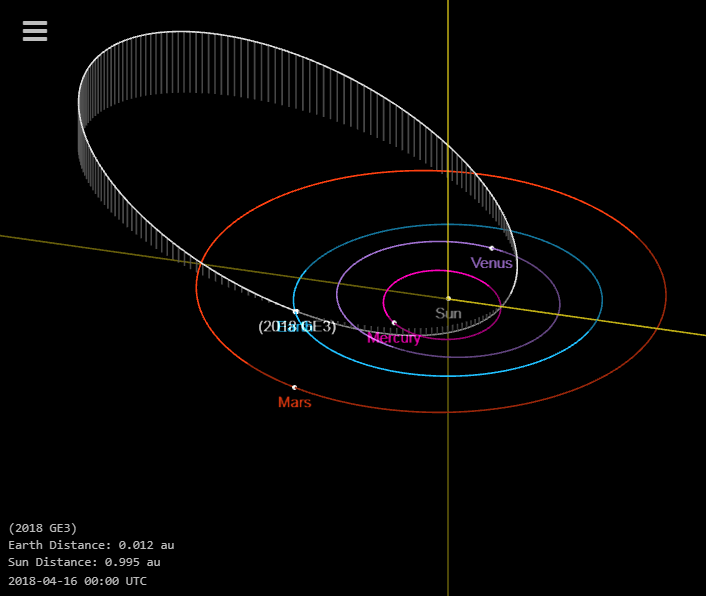We dodged a bullet today. It came within one half of the distance to the moon.
I got this notice in email from NASA about a surprise asteroid that gave us only one day of warning passing halfway between the Earth and the moon. It was the largest known asteroid to ever pass that close to Earth in observational history.
SURPRISE ASTEROID FLYBY: With little warning, on Sunday, April 15th, a "Tunguska-class" asteroid about the size of a football field flew through the Earth-Moon system. 2018 GE3 was discovered just the day before as it plunged inward from the asteroid belt. A quick-thinking amateur astronomer in Europe was able to record a video of the asteroid as it flew by.
With little warning, a relatively large asteroid flew through the Earth-Moon system on April 15th only 192,200 km (0.5 Lunar Distance) from our planet. 2018 GE3 was discovered by the Catalina Sky Survey approaching Earth on April 14th. Hours later, amateur astronomer Michael Jäger of Weißenkirchen Austria video-recorded the space rock rushing through the southern constellation Serpens:
IMAGE: 2018 GE3 an asteroid from the inner regions of the asteroid belt, classified as a near-Earth object, approximately 37-138 meters (100-500 feet) in diameter. It was first observed on 14 April 2018, only one day prior to its sub-lunar close encounter with Earth at 0.50 LD (0.00128 AU) on 15 April 2018. It is the largest known asteroid to ever pass that close to Earth in observational history. Animation by Michael Jäger
According to Wikipedia, 2018 GE3 is the largest known asteroid to pass that close to Earth in observational history," says Jäger. "It was shining like a 13th magnitude star at the time of my observations."Based on the intensity of its reflected sunlight, 2018 GE3 must be 48 to 110 meters wide, according to NASA-JPL.
This puts it into the same class as the 60-meter Tunguska impactor that leveled a forest in Siberia in 1908. A more recent point of comparison is the Chelyabinsk meteor-a ~20-meter asteroid that exploded in the atmosphere over Russia on Feb. 15, 2013, shattering windows and toppling onlookers as a fireball brighter than the sun blossomed in the blue morning Ural sky. 2018 GE3 could be 5 to 6 times wider than that object.
If 2018 GE3 had hit Earth, it would have caused regional, not global, damage, and might have disintegrated in the atmosphere before reaching the ground. Nevertheless, it is a significant asteroid, illustrating how even large space rocks can still take us by surprise. 2018 GE3 was found less than a day before before its closest approach.
Based on an observational arc of only 1 day, 2018 GE3 appears to follow an elliptical orbit which stretches from the asteroid belt to deep inside the inner solar system. Every ~2.5 years the space rock crosses the orbits of Mercury, Venus, Earth, and Mars - although not necessarily making close approaches to the planets themselves.
NASA Jet Propulsion Laboratory has made an interactive orbit viewer available online here




Comment: Whew! That was a close one! Is this a 'shot across the bow' from Mother Nature? Perhaps next time, or in the future, we won't be so lucky. Here's a few recent near misses: